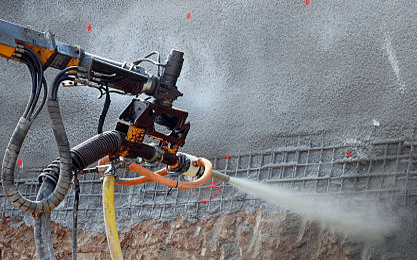Understanding Australian Standards for Concrete, Grout & Screed Equipment Use

According to Safe Work data from SafetyCulture.com.au, Australia is the 7th safest country to work in the entire world. Although Australia is sometimes perceived as highly regulated, it’s this adherence to strict rules and high quality that makes it an incredibly safe country to live and work.
The same data indicates that construction ranks as the third highest industry for workplace fatalities, following agriculture and transport. However, the number of incidents remains significantly lower than in many other countries.
Australia maintains exceptionally high standards not only in safety but also in quality, workmanship, and regulatory compliance. That is where the importance of adhering to Australian Standards in construction comes in. Every construction worker can tell you that the most important part of getting a building right is the beginning: building on a solid foundation.
So, what are the Australian Standards for concrete, grout & screed equipment, and how do they contribute to a safer, higher-quality construction industry?
What are Australian Standards?
Developed by Standards Australia, Australian Standards is a regulatory framework that covers everything from consumer products and services to the environment, construction, energy, and water utilities. In short, these standards ensure the safety and high quality of construction and public amenities across the country.
Construction equipment covers a wide range of machinery, from concrete placing equipment and cranes to grout and screed tools. The following Australian Standards ensure safe operation and high-quality workmanship across these essential tools.
Key Standards for Construction Equipment Use
AS 2550.15: Concrete Placing Equipment – Safe Use
According to the Concrete Pumping Association of Australia Inc., AS 2550.15 specifies the requirements for the safe operation of concrete placing equipment. This includes the planning, site placement, erection and dismantling, maintenance, inspection, assessment, testing and any other specific requirements of concrete placing equipment.
This requirement, for example, details the inspection requirements for concrete work and prescribes guidelines for operating concrete placing equipment safely and responsibly.
AS 1418.15: Cranes (including hoists and winches)
AS 1418.15 is an Australian Standard governing the design, construction, and operation of cranes, hoists, and winches to ensure all lifting machines’ safe and proper functioning. The standard outlines guidelines for safely operating, maintaining and testing lifting machines to prevent accidents and to optimise efficiency. The Standard applies to both mobile and fixed cranes but is not limited to those in construction, including the mining industry, shipping ports and warehousing, and other sectors.
AS/NZS 4024.1: Safety of Machinery series
This standard applies to both Australia and New Zealand and focuses on the safety of machinery. This includes guidelines for every step of the machinery process, from designers, manufacturers, and suppliers to employers and end users, that can reduce the risks associated with construction machinery use. It is based on international standards, with some modifications required for specific Australian safety.
Compliance Requirements for Concrete, Grout & Screed Equipment Operators
These compliance requirements include operator training, certification, and adherence to safety protocols in the Australian construction industry. This includes regular equipment inspection and maintenance protocols and maintaining documentation and record-keeping for audits.
Benefits of Complying with Australian Standards
Australian Standards, along with robust legal and regulatory frameworks, make the construction industry one of the safest in the world.
With enhanced site safety and reduced accidents, construction workers can complete their work in alignment with the highest and safest operational guidelines, optimising the techniques of the various types of equipment to eliminate issues and provide a solution to unsafe practices. It also increases the operational efficiency of the job site and improves the equipment lifespan, saving contractors money by investing in their equipment as designed.
Common Challenges in Meeting Standards
Although high standards ensure safety, competence, and superior construction quality, they also present challenges, including training gaps and the high costs associated with certification. Not everyone in the industry is aware of the standards that apply to their workplaces, but it is vitally important to keep up to date with modern practices and regulatory requirements.
Tips for Ensuring Compliance on Construction Sites
Ensure your staff remain up to date with Australian Standards by implementing regular training programs and partnering with accredited equipment suppliers, such as CGS Equipment. We provide on-site training for all your grout, screed and concrete equipment, ensuring your workers are fully informed on current standards.
It is also best to conduct periodic audits and assessments to ensure that your job sites are keeping current with safe and quality standards. For that, you need experts in the field. Partner with CGS Equipment Australia to optimise the performance and safety of your concrete placing equipment. Contact our expert team to learn more about how we can make safe and improve your concreting work sites.
Frequently Asked Questions
What is the Australian standard for concrete?
It is a regulatory framework designed to ensure the safe application and operation of concrete construction in Australia.
What is the Australian standard AS1379?
AS1379 outlines the minimum requirements for the supply of concrete, including materials, production, delivery, and the testing of both plastic and hardened concrete.
What is the standard code for concrete?
AS 2550.15 is the Australian Standard for concrete placing equipment, providing nationwide guidelines for the safe operation of cranes, hoists, and winches. AS1379 covers with the supply, production, delivery, and testing of concrete products.
What are the AS1012 methods of testing concrete?
AS1012 outlines the various methods used in Australia to test concrete quality. This includes compressive strength, indirect tensile strength, and flexural strength tests.

